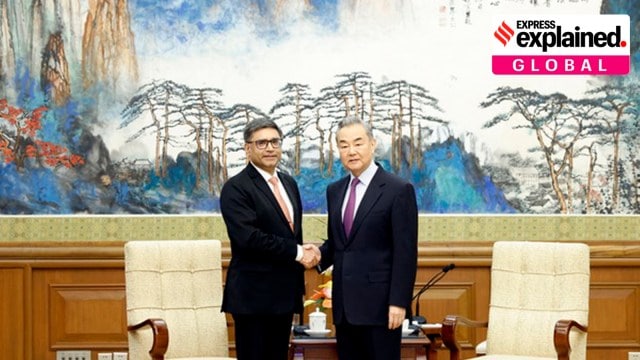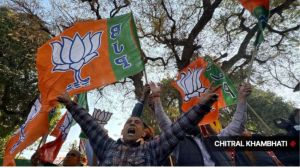India-China diplomatic thaw: what the fine print of their statements reveals
After a recent diplomatic breakthrough, both India and China have come out with their statements. A careful reading reveals interesting convergences and divergences on various key issues. Take a look.
 Chinese Foreign Minister Wang Yi and India's Foreign Secretary Vikram Misri during a meeting, in Beijing, Monday, Jan. 27, 2025. (@China_Amb_India via PTI Photo)
Chinese Foreign Minister Wang Yi and India's Foreign Secretary Vikram Misri during a meeting, in Beijing, Monday, Jan. 27, 2025. (@China_Amb_India via PTI Photo)In a major diplomatic breakthrough, New Delhi and Beijing have decided on a slew of measures to repair bilateral ties: resuming Kailash Mansarovar Yatra this summer, restoring direct flights between the two capitals, issuing visas for journalists and think tanks, and sharing trans-border river data, a statement from the Ministry of External Affairs (MEA) said on Monday.
These decisions were arrived at after Foreign Secretary Vikram Misri, during a recent China visit, met the country’s Vice Foreign Minister Sun Weidong, Foreign Minister Wang Yi, and Minister of International Department of the Communist Party of China Liu Jianchao.
But the fine print of the two countries’ statements reveal convergences and divergences in their approach.
On the framing of the meeting
While India talked about what was “agreed” between Prime Minister Narendra Modi and China’s President Xi Jinping in Kazan, China talked about the “important consensus” reached by the leaders.
India said they “reviewed the state of India-China bilateral relations comprehensively” and agreed to take certain “people-centric steps to stabilise and rebuild ties”. So, the focus is on “review” and “people-centric steps”.
China said that they were discussing measures for the “improvement and development” of China-India relations, and that the two sides reached “consensus” on specific measures.
Thus, Delhi’s statement is more nuanced and cautious, while Beijing has a more optimistic assessment of the talks.
Mansarovar Yatra, flights
On Kailash Mansarovar Yatra, the two statements almost echo each other, but the Chinese statement reflects more urgency, with a mention of “as soon as possible”.
The Indian statement said the two sides “decided to resume the Kailash Mansarovar Yatra in the summer of 2025; the relevant mechanism will discuss the modalities for doing so as per existing agreements”.
The Chinese statement said: “The two sides agreed to resume the Indian pilgrims’ visit to Kailash Mansarovar in Xizang Autonomous Region, China in 2025, and will discuss relevant arrangements as soon as possible.”
On direct flights, a careful reading of the two statements shows that Delhi wants a new pact, while China has linked it to visas and resident journalists.
Chinese and Indian airlines had 539 scheduled direct flights a month between the two countries as of December 2019, with a cumulative seat capacity of over 1.25 lakh. They were paused during the Covid-19 pandemic in 2020, and with the Galwan clash in June that year, were never resumed.
The Indian statement said: “They agreed in principle to resume direct air services between the two countries; the relevant technical authorities on the two sides will meet and negotiate an updated framework for this purpose at an early date”.
China said: “The two sides agreed to resume direct flights between Chinese mainland and India, support the competent authorities of the two countries to coordinate and push it forward, and take measures to facilitate personnel flows and exchanges of resident journalists”.
India currently has only one resident journalist in China, while the Chinese have none.
On 75th anniversary of India-China ties
On the commemoration of the 75th anniversary of ties — the two countries had established diplomatic ties in 1949 — the emphasis is again a bit different. While the Indian government is looking at “restoring public trust”, the Chinese have linked it to visas.
While China claims it is issuing a large number of visas to Indian nationals, Indian visa issuances to Chinese nationals have reportedly crashed from around 2 lakh in 2019 to a few thousands in 2024. In January 2024, the Chinese embassy in Delhi had said that over 180,000 Chinese visas were issued to Indian citizens in 2023.
So, the Indian statement reads: “The two sides recognise that 2025, being the 75th anniversary of the establishment of diplomatic relations between India and China, should be utilised to redouble public diplomacy efforts to create better awareness about each other and restore mutual trust and confidence among the public. The two sides will conduct a number of commemorative activities to mark this anniversary.”
Separately, India said, “The two sides agreed to take appropriate measures to further promote and facilitate people-to-people exchanges, including media and think-tank interactions.”
China said, “The two sides agreed to jointly commemorate the 75th anniversary of the establishment of diplomatic relations between China and India in 2025, and carry out media and think tank exchanges, Track II dialogues and other people-to-people exchanges.”
Trans-border rivers
On trans-border rivers like the Brahmaputra, both sides agreed to hold an early meeting of India-China Expert Level Mechanism. This will involve sharing of data, which has been an issue recently.
In early January, days after Beijing cleared the construction of the world’s largest dam on the Brahmaputra close to the Indian border, triggering worries in the lower riparian states of India and Bangladesh, Delhi said it has conveyed its concerns to the Chinese side.
India was not informed by the Chinese side about the dam project, which is the convention between the two countries, and learnt of it from media reports. Indian officials then reached out to their Chinese counterparts about sharing information in advance, and consulting India and Bangladesh. Something like this can be prevented if the expert-level mechanism meets regularly and shares information.
India: “They also agreed to hold an early meeting of the India-China Expert Level Mechanism to discuss resumption of provision of hydrological data and other cooperation pertaining to trans-border rivers”.
China: “The two sides agreed to advance trans-border river cooperation, and maintain communication on holding a new round of meeting of the China-India Expert Level Mechanism on Trans-border Rivers at an early date.”
The overall approach
The two statements also outlined their overall approach.
This indicated that India wanted a “step-by-step” approach to address areas of “interest” and “concern” — referring to the border situation.
The Indian statement said, “The two sides took stock of the extant mechanisms for functional exchanges. It was agreed to resume these dialogues step by step and to utilise them to address each other’s priority areas of interest and concern.”
Sticking to their ‘long-term approach’ strategy, the Chinese statement said, “The Chinese side stressed that both sides should view and handle China-India relations on the basis of the fundamental interests of the two countries and two peoples and from a strategic height and long-term perspective, actively advance exchanges and practical cooperation with a candid and constructive attitude, guide the public opinion in a positive way, enhance mutual trust, and properly handle differences, so as to promote the development of China-India relations along the sound and stable track.”
Notable silences
On some issues, one of the two countries was silent.
On trade, the Indian side spelt out their concerns on market access. “Specific concerns in the economic and trade areas were discussed with a view to resolving these issues and promoting long-term policy transparency and predictability,” Delhi’s statement said.
The Chinese did not make any mention of this.
And, on SCO, China said, “The Indian side will extend full support for Chinese presidency of the Shanghai Cooperation Organization, and will actively participate in the meetings under the SCO umbrella.”
India made no mention of this.
Besides the two official statements, the Chinese Foreign Ministry readout of the meeting between Misri and Wang, translated from Mandarin by Chinese state-backed media outlet CGTN, said: “The two countries should refrain from mutual suspicion, mutual estrangement and mutual exhaustion, said Wang…”
Interestingly, his framing of the three mutuals was in sharp contrast to India’s. External Affairs minister S Jaishankar has, in the past, outlined that India’s approach can be summed up in terms of “the three mutuals — mutual respect, mutual sensitivity and mutual interests”.
More Explained
Must Read
EXPRESS OPINION
Feb 20: Latest News
- 01
- 02
- 03
- 04
- 05













































